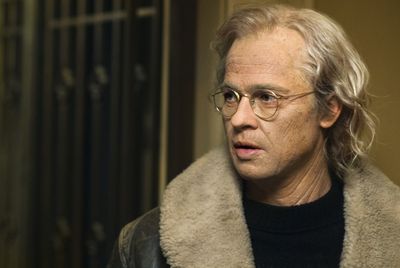‘Button’ a constant time shift

In “The Curious Case of Benjamin Button,” time doesn’t just slip away. It surges like a tsunami, swamping cities and washing aside human lives like so much Mississippi Delta topsoil.
It rolls backward and forward like a movie projector, unspooling the tale of a man whose peculiar fate is to age in reverse, starting his life as a wrinkled old codger and ending it as a newborn babe.
So powerful is time’s presence in the film that it almost becomes a character, as does the sepia-toned city of New Orleans, where much of the action takes place.
Thoughts about time and mortality left a deep mark on many of those connected with the project, including director David Fincher, screenwriter Eric Roth, producer Kathleen Kennedy and Brad Pitt, who stars in the title role.
“It’s not about a life lived forward or backward; it’s about a life lived well,” says Kennedy, who devoted many years of her life to bringing “Benjamin Button” to the screen over a Greek chorus of studio skepticism.
“It forces you to confront the choices that you’ve made along the way.”
Loosely based on a fable-like 1922 short story by F. Scott Fitzgerald, the film, which opened Thursday, is an epic romance about star-crossed lovers whose overlap in each others’ lives is achingly brief. (Warning: spoilers ahead.)
Like a man with a medieval spell upon him, Benjamin starts his life at age 80 on Armistice Day, 1918, and goes on to live through many of the highs and lows of the so-called “American Century.”
During the course of the film, Pitt is transformed from a creaky octogenarian to a strapping seaman to a dashing world adventurer able to win the heart of his longtime flame, Daisy Fuller (Cate Blanchett), a ballerina who first meets Benjamin when she’s a precocious child and he’s a virginal elder.
Playing an American Everyman with a grave-to-cradle character arc sounds daunting. But People magazine’s two-time “Sexiest Man Alive” says he was fascinated to see himself stooped and shriveled – with the aid of several diminutive body doubles and some sophisticated CGI effects.
“I was actually quite intrigued to see where it might be heading,” Pitt says, adding that he “got to have some say” in exactly how decrepit he would appear on screen.
“I doubt time and gravity will be as kind as I was to myself,” he says with a smile. “It just made me think about the ticking clock.”
Fincher, who previously teamed with Pitt on the crime thriller “Se7en” and the cult film “Fight Club,” sees Benjamin as a “witness” who is “purely present” in every moment of his long life.
The key to the strength of Pitt’s performance, he believes, is that the actor taps into that same quality.
“I think Brad somehow manages to be an Everyman, which is on the face of it just a ludicrous notion,” Fincher says, alluding to Pitt’s ubiquitous mass-media persona. “It’s a beautiful performance.”
Roth’s screenplay offers a kinder, gentler take on Fitzgerald’s Proustian parable, which is a whimsical, somewhat caustic yarn about how the serious-mindedness of the Civil War era was gradually usurped by the frivolousness of the dawning Jazz Age.
He acknowledges some similarities between Benjamin’s story and “Forrest Gump,” which earned Roth a 1994 Oscar for adapted screenplay.
“But I think this is a much different movie,” he says. “Not that I’m knocking the other one, (but this) is a deeper movie.”
Bathed in rich, dark colors by director of photography Claudio Miranda and wrapped in a tender, yearning atmosphere, the film finds a stirring visual symbol in New Orleans (a switch from Fitzgerald’s original Baltimore setting).
Pitt, who has become deeply involved since Hurricane Katrina in efforts to rebuild New Orleans through a foundation he operates with producer-financier Steve Bing, calls the decision to shoot there “absolutely serendipitous.”
“Suddenly, it just gave it a whole new gravitas. It gave it this pulse,” he says.
“There’s something timeless about New Orleans to begin with. And it’s a place of mystery and magic where you could believe something like this could happen.”